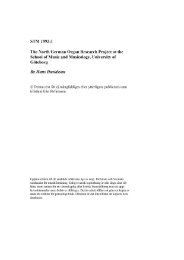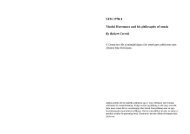Recensioner - Svenska samfundet för musikforskning
Recensioner - Svenska samfundet för musikforskning
Recensioner - Svenska samfundet för musikforskning
Create successful ePaper yourself
Turn your PDF publications into a flip-book with our unique Google optimized e-Paper software.
anyone interested in the origins and development<br />
of the Jew’s harp. It offers much previously uncollected<br />
and unconnected information, concisely<br />
described and presented in a manner that invites<br />
fruitful exploration and comparison. The chronological<br />
range which emerges from the data, for<br />
instance, proves highly significant. It enables the<br />
author to confirm beyond reasonable doubt Jaap<br />
Ypey’s 1976 proposition that the European<br />
instrument is essentially a medieval and postmedieval<br />
phenomenon, first appearing there probably<br />
not much earlier than the 13th century.<br />
This is a most positive, satisfying and consequential<br />
result, contradicting popular myths and antiquarian<br />
claims of Viking Age, Roman and even<br />
earlier precursors through the simple application<br />
of due archaeological process.<br />
But the work has its wider implications too,<br />
which will be quickly apparent to students of<br />
music’s pre- and proto-history. One remarkable<br />
feature of European Jew’s harps which the book<br />
reveals is that at their very first appearance the<br />
technology of their manufacture and the principles<br />
of their operation as musical instruments<br />
already seem fully developed. Then, in the space<br />
of maybe as little as a hundred years, they expand<br />
from a few scattered finds to become a widespread<br />
and numerous class, exhibiting close consistencies<br />
in their forms and constructions. Such a<br />
controlled explosion parallels other case histories<br />
which have so far figured more conspicuously in<br />
music-archaeological studies.<br />
The complexity of the forms of stringed<br />
instruments at their abrupt first appearance in the<br />
archaeological record, at Ur in Mesopotamia<br />
more than 5,000 years ago, is one such. Equally<br />
remarkable is the technical sophistication of the<br />
first metal horns, produced by Scandinavian and<br />
Irish Bronze Age cultures between around 3,500<br />
and 2,500 years ago. These sudden floruits, still<br />
poorly understood, already invite a number of<br />
important philosophical and scientific questions,<br />
both about the nature of musical and music-technological<br />
innovation in our human past and<br />
about the character and representativeness of<br />
archaeological survival. But whereas studies of<br />
instruments of those grander kinds are hampered<br />
by the small sizes of their respective samples, the<br />
diminutive Jew’s harp and its archaeological<br />
<strong>Recensioner</strong><br />
abundance now offer opportunities to observe in<br />
fine detail music-related developments taking<br />
place through well-charted archaeological time.<br />
Indeed, as a result of this new study its numbers<br />
and contextual data are for the first time statistically<br />
significant.<br />
If Kolltveit’s Jew’s harps thus offer ‘music<br />
archaeology’ new ways of looking at its source<br />
materials, it is surely a timely development, as<br />
archaeological finds become more and more relevant<br />
to our understanding of music’s origins, and<br />
even of the origin of our species. Although archaeologists<br />
have until recently seemed to attach<br />
little importance to sound and music (preferring<br />
to label them merely aspects of ‘entertainment’ or<br />
‘ritual’ and then leave them to ethnomusicologists<br />
to puzzle over) their attention since the<br />
1990s has been turning increasingly towards the<br />
evolution of the modern human mind, and in<br />
particular of those cognitive and communications<br />
skills which contribute to making us human. Of<br />
these, use of language may be inferred, for<br />
example, from patterns detectable in the prehistoric<br />
use and development of sites, tools and materials,<br />
and from studies of brain-structures<br />
evidenced in ancient fossil crania. Capacities for<br />
vocalisation may be deduced from the surviving<br />
anatomy of the early human vocal tract. Music’s<br />
prehistory, on the other hand, is evidenced directly,<br />
in the form of instruments. In the Upper Palaeolithic<br />
(the epoch from around 40,000 to 10,000<br />
years ago) we now have several finds of bone<br />
pipes with multiple finger-holes, beautifully<br />
made, for some of which we have dates in excess<br />
of 36,000 years ago. Even at that first appearance,<br />
just as in Sumer and in Bronze Age Scandinavia,<br />
their designs are already sophisticated.<br />
Such ancient finds are naturally of considerable<br />
interest to university students, for whom the<br />
glittering prize of music’s ultimate origins offer a<br />
perennial challenge. But in reality it is not so easy<br />
a problem to address. Without a proper understanding<br />
of musical traditions as they appear in the<br />
archaeological record, such approaches are inevitably<br />
premature, and flawed. It is therefore encouraging<br />
to find, in Kolltveit, an author who<br />
understands the acuteness of our need for more<br />
and better archaeological evidence of musical traditions<br />
– of whatever kind – and who is not<br />
131

















